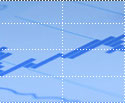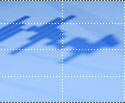|
|
|||||||
|
|
|||||||
 |
|
||||||
|
WHAT THE MARKET WANTS: August 2008
Volatility Reigns as Stocks Grapple for a Bottom Volatility reigned supreme last month. An early July freefall gave way to a short-term bottom when fear spiked higher amid mounting concerns that several key financial institutions were on the brink of bankruptcy. This rampant pessimism drove the market indices into bear market territory for the first time since 2002 and the DJIA and S&P 500 to two-year lows by July 15. Fannie Maeís and Freddie Macís stock prices tumbled into single digits, the lowest levels since 1991. This selloff actually marked the capitulatory bottom of the most recent down-leg within the broader market downtrend. Wells Fargo reported better-than-expected earnings and a dividend increase, which sparked a fierce and broad-based two-day rally on July 16, fueled by the beaten down financials and aided by short covering. After all the dust had settled, the Nasdaq finished July with a gain of 1.4%, while the S&P 500 slipped 1%. The DJIA was flat, up 0.3%. It was a tale of two markets in July, as the lower end of the market cap spectrum posted solid gains across the board, led by value, while the upper end of the cap spectrum lagged way behind. All micro-cap and small-cap segments posted gains of at least 2.3% in July, with micro-cap value (5.5%) leading the way. In contrast, mid-caps and large-caps never made it out of the red, ranging between -0.6% for large-cap value to -3.8% for mid-cap growth. This divergence in performance is typical at the beginning of bull market runs, as small-caps tend to benefit more acutely from economic expansion. Small-caps have led the way for several months, so there is hope that the market is turning the corner. However, hope is a four-letter word. The reality is that we are in the midst of a year-long slide in stocks, so we may be witnessing the exception to the rule. In a repeat of last month, the market continues to reward stocks with favorable momentum metrics. Stocks with steady and predictable earnings history were also favored, which is normal during bear markets and heightened uncertainty. The previously invulnerable energy and materials sectors (each down more than ten percent over the last month) have started to show some major cracks. This is due to falling oil prices and fears of sluggish demand for commodities moving forward, because of weakness in the global economy. However, these earlier intermediate-term pullbacks have been met with renewed vigor over the last several years, and so we expect both sectors to continue their long-term treks higher following a corrective process. As energy and materials have moved lower, the financials have rallied sharply during the last month. Some of the gains were sparked by short covering, as evidenced by 30-40% moves for many beaten-down stocks in a matter of days after the July 15 bottom. The fact is that much uncertainty still abounds for the financial sector more than one year after the sub-prime debacle began, and things continue to get worse. Although many pundits have called this most recent selloff THE bottom, this marks the third capitulatory "bottom" in 2008. From a technical standpoint, the major indices are charting a price pattern of lower highs and lower lows -- the classic definition of a downtrend. As we stated last month, we continue to believe it is imprudent to call a bottom with so much uncertainty surrounding the markets. Simply put, the best predictor of future behavior is past behavior. Until the major indices take out recent highs from mid-May, the intermediate-term trend remains down. However, the recent consolidation for the major indices is constructive and an indication that the markets may be heading higher in the short-term. We just don't see any catalysts that will drive the stock market higher in the coming months. Remain cautious. Next update: Second week of September. |
|
|
|
|
|
Copyright © 2000-2008 Sabrient Systems, LLC. All rights reserved.




